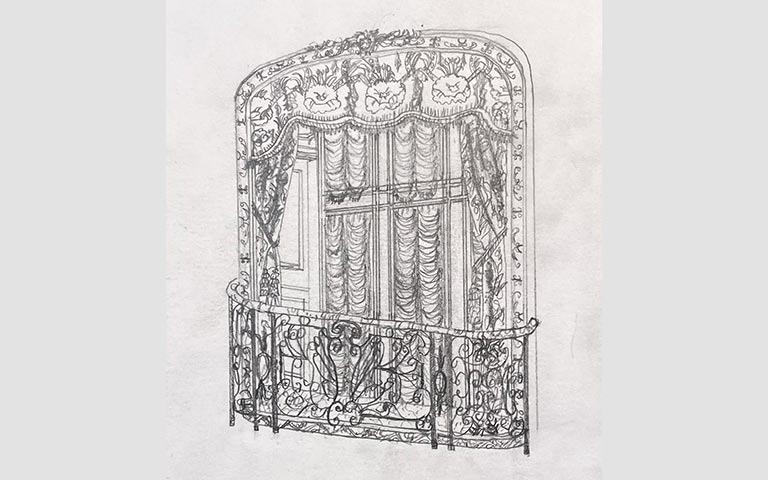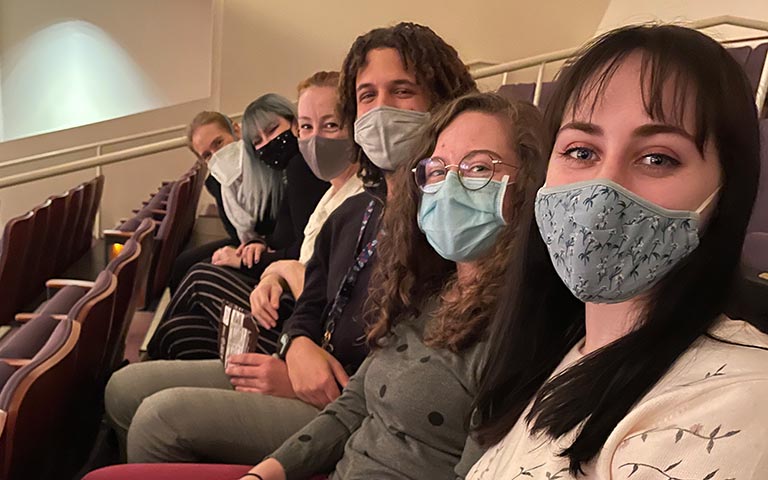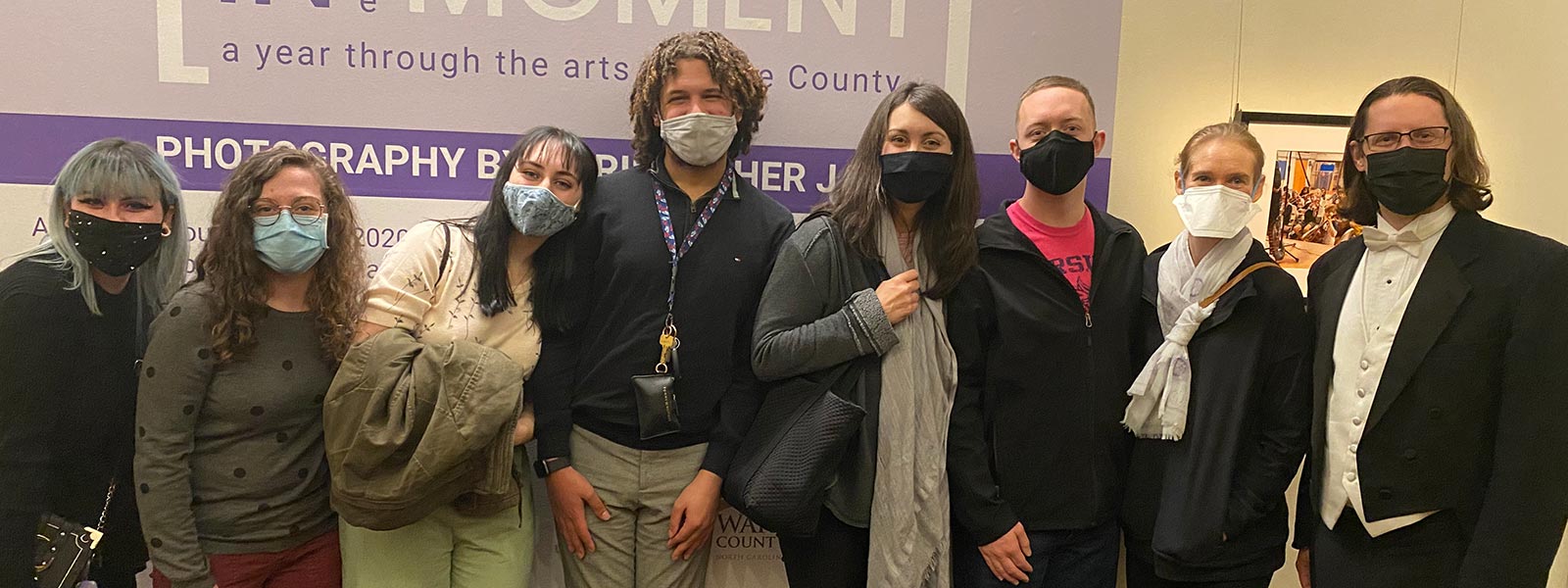Faculty Enrichment Grants support real-world art and cultural experiences for students
A concert, a master class, a trip to a cultural heritage site, an off-campus show. Each year, Faculty Enrichment Grants from the Thomas S. Kenan Institute for the Arts help support University of North Carolina School of the Arts (UNCSA) faculty members' endeavors to enhance the arts experiences of their students and provide real-world applications to their classroom education.
The grants, which the Kenan Institute has been distributing for nearly a decade, are awarded on a rolling basis throughout the year and offer UNCSA faculty an opportunity to augment student learning by subsidizing costs of virtual and local off-campus performances, exhibits, screenings and guest lectures. In the 2021-22 academic year, 18 Faculty Enrichment Grants were awarded, impacting around 378 students.
As part of the simple application process, faculty members are asked to consider how the event will support student learning outcomes in their respective classroom, studio or lab. For faculty like John Coyne, Director of the Scene Design program in the School of Design & Production, and Jaren Atherholt, Assistant Professor of Oboe in the School of Music, that's an easy line to draw.
Both received Faculty Enrichment Grant funding for the 2021-22 academic year to take their students on off-campus trips. Coyne's Scene Design students ventured to Biltmore Estate in Asheville, N.C. to study the home's architecture, design and history. Atherholt's oboe studio traveled to a concert by the North Carolina Symphony in Raleigh, N.C. The performance featured works with significant oboe excerpts that the studio had previously studied in class.
True to their name, the grants also enrich the faculty experience. For Coyne, the visit to Biltmore was an opportunity to spend the day with his students discussing and enjoying a place many of them had never been before. And for Atherholt, the trip to the North Carolina Symphony helps sustain a goal she set when she first came to teach at UNCSA.
Art, architecture and design
A trip to Biltmore Estate gave UNCSA scene design students an opportunity to learn firsthand about architectural styles and historical details they studied in class. A Faculty Enrichment Grant helped fund travel and ticket costs for the trip.
Designers work in a visual vocabulary. In order for designers to draw from the world around them, they must learn to look and observe. Our trip to the Biltmore House was to do just that.
John Coyne
"Designers work in a visual vocabulary," Coyne says. "In order for designers to draw from the world around them, they must learn to look and observe. Our trip to the Biltmore House was to do just that."
"In addition to seeing firsthand specific periods of architecture, décor and furniture, the goal was to provide an experience that showed the student designers an environment that was perhaps unfamiliar to them," he adds. "There they could observe the qualities that design includes, such as form, detail, color, proportion and scale."
To document their trip, students were asked to draw the aspects of the estate they found most personally interesting. Second-year undergraduate Jennifer Kroon-Nelson was particularly drawn to the architectural details and history of the home.
"This experience was significant to me as an artist and student because it allowed me to step into a place in history. One of the highlights was being able to learn the family's history and connection to each room as you went through the house," says Kroon-Nelson. "In hearing facts about the family, you could picture their life in the house and bring life to the projects we worked on."

A sketch of the nursery window by Kroon-Nelson. "One of my favorite subjects that I drew was the bay window in the nursery," she says. "I was able to examine multiple forms of detail in one drawing: folds of fabric, wrought iron, carved wood and patterned fabric."
"After this trip, I can apply what I've learned about visualization to art and productions I will work on in the future," she adds. "I learned to use the history around you to bring life to the art you are creating."
The Faculty Enrichment Grant, Coyne says, expands the amount of similar opportunities he's able to offer to his students. "Even with student discounts, the Biltmore trip and ticket costs are more than we have in our budget for this type of thing and are out of reach for most students to pay for individually. It is so valuable for the students to have a shared experience in a new and enriching place."
A concert and a bonding experience
Each year, Atherholt aims to take the UNCSA oboe studio to as many off-campus concerts as possible. This year's line-up included a performance by the North Carolina Symphony at Meymandi Concert Hall in Raleigh. The concert included Stravinksy's "Pulcinella" and Prokofiev's "Classical Symphony," both of which feature significant oboe excerpts. A Faculty Enrichment Grant helped fund travel and ticket costs for the event.

Students at the North Carolina Symphony performance.
Atherholt sees those off-campus trips as a chance for her students to bond not only with each other, but with a broader community of oboists.
"There was a need to show the students that it's important to support the musicians in our community," she says. "I'm in my fifth year at UNCSA and I've been working to build these relationships with other oboists in the state and create a community of support for the oboes. Going to support the oboists in these orchestras is an important part of that."
"It's also important as a studio to do things together that are not on campus," she adds. "When you travel, you bond in a certain way, it's a change of pace." Students traveled together, had dinner before the concert and, afterwards, met with the symphony's principal oboist and bassoonist.
"Experiencing the North Carolina Symphony live was an amazing opportunity," says third-year undergraduate Kaylin McClafferty. "'Pulcinella' was especially a treat to hear since it's not programmed often. The principal oboist, Melanie Wilsden, did an amazing job and it was very inspiring to hear her play and speak to her about her experience with the piece afterwards. I think listening to beautiful oboe playing is the best way to learn."
Having a resource like the Faculty Enrichment Grant makes me feel supported and valued as a faculty member and like the institution believes in me.
Jaren Atherholt
For Atherholt, the grant has helped bolster a goal she set when she first came to UNCSA. "My goal when I got this job was to take the students to the North Carolina and Charlotte symphonies at least once a year. The first year I paid for it myself because I didn't know about this grant," she says. "It is so meaningful and inspiring to the students. The support from the Kenan Institute makes me feel like I could sustain something like this."
"Having a resource like the Faculty Enrichment Grant makes me feel supported and valued as a faculty member and like the institution believes in me."
April 29, 2022






